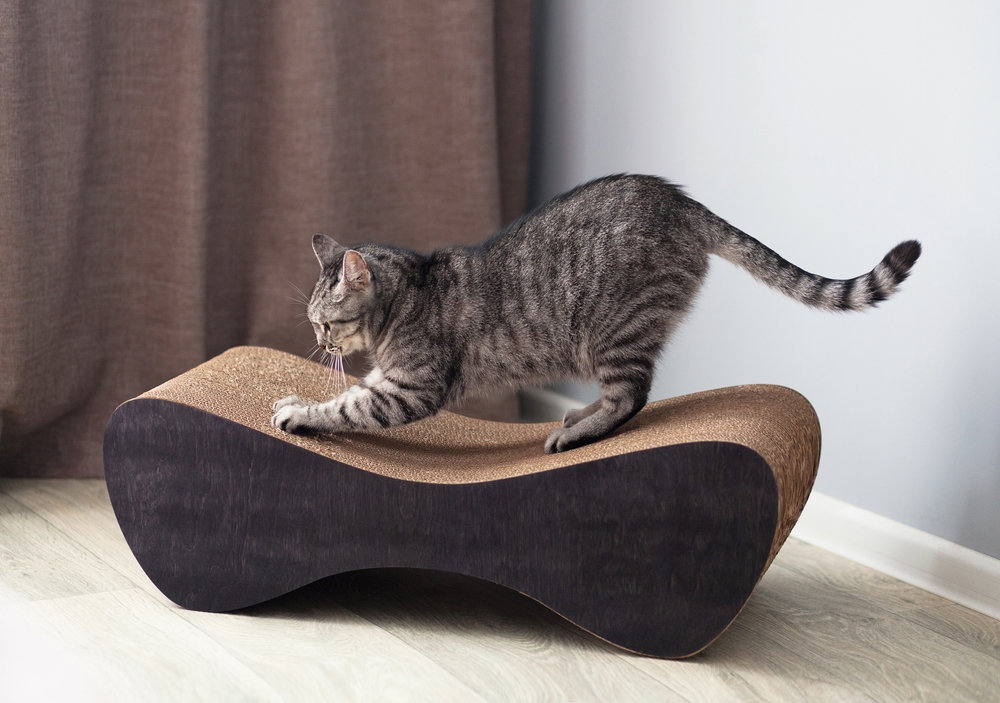Cats scratch instinctively, and you likely want to prevent your cat from shredding your furniture. Fortunately, you can support your cat’s instinctive need to scratch and avoid putting them through a declawing procedure. Our Village Animal Hospital team shares declawing alternatives that will leave your cat happy, and your couch intact.
Why do cats scratch?
Cats instinctively scratch. Cats’ scratching behavior serves multiple functions:
- Claw maintenance — Cats’ claws grow in layers, and scratching removes the worn outer layer to expose the new growth underneath. In addition, scratching keeps cats’ claws at an optimal length.
- Stretching — Cats stretch their muscles by rising on their hind feet, arching their back, extending their legs, and extruding their claws. Cats extend their spine and maintain flexibility through whole-body stretching.
- Express emotion — Your cat may scratch when excited, stressed, or anxious.
- Marking territory — A cat’s paws have scent glands that—when they scratch—leave chemical messages for other cats.
What is declawing for cats?
A cat’s third phalanx (i.e., toe bone) is amputated during the elective declawing procedure. A cat’s claws are attached to the toe bone, and the procedure is equal to the amputation of a person’s finger at the last joint. In the past, some people mistakenly viewed declawing their cats as a harmless solution to stop unwanted scratching. However, declawing can lead to your cat experiencing lifelong pain, stress, and behavior disorders, which is why the American Association of Feline Practitioners strongly opposes declawing. Fortunately, many more humane and effective methods are available to help curb your cat’s inappropriate scratching.
What are declawing alternatives for your cat?

Many humane and effective alternatives to declawing are available. These declawing alternatives will deter your cat from inappropriate scratching, and help them satisfy their instinctive needs:
- Provide your cat with scratching posts — Ensure your cat has appropriate outlets for their natural scratching instinct by placing scratching posts near their food and water, litter box, and favorite napping places. Most cats like to scratch vertically, so the scratching posts should be taller than your cat’s body length. You can determine your cat’s scratching post preference by giving them scratching posts that each has a different shape and surface texture. The scratching post they use the most is likely the type they prefer.
- Trim your cat’s claws regularly — Reduce your cat’s scratching frequency and intensity by trimming their nails regularly. Trimming a cat’s nails takes a little practice, and your veterinarian can advise you and demonstrate an effective technique. Always use feline nail trimmers, which give you better control to prevent the nail’s splintering. Remember to always trim your cat’s nails in a calm environment, and provide positive reinforcement by rewarding them with a high-value treat.
- Use temporary synthetic nails caps — You can glue these nail caps to your cat’s trimmed front claws to prevent damage to furniture and injury to people. The caps usually remain adhered to the nails for approximately 4 to 6 weeks, and come in an array of colors and styles.
- Use feline pheromone spray — Pheromones can reduce your cat’s stress and anxiety, decreasing unwanted behaviors such as inappropriate scratching. Apply pheromone spray to the area or object where your cat scratches inappropriately, or use a room diffuser to deter scratching.
- Encourage appropriate scratching by applying a cat attractant — When applied to a surface, Feliscratch by Feliway entices your cat to scratch appropriate surfaces such as scratching posts.
- Create safe places for your cat — To help prevent stress- or anxiety-related scratching, ensure your cat has areas in your home where they can retreat for privacy and safety. In addition, your cat may enjoy an elevated perch (i.e., cat tree) where they can observe their surroundings while feeling safe and secure.
- Provide your cat with appropriate environmental enrichment — Provide your cat with intellectual stimulation and physical activity to help deter destructive behavior such as inappropriate scratching. Encourage your cat to engage in instinctive behavior, such as hunting and stalking prey, by providing food puzzles, foraging toys, and motion-activated toys.
Scratching is essential to your cat’s wellbeing, and you can redirect and manage their scratching through cat-friendly methods. If you have questions about your cat’s inappropriate scratching behavior, contact our Village Animal Hospital team to schedule an appointment.








Leave A Comment